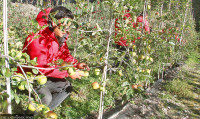National
Fresh research puts hydel potential in Nepal at 72,000MW
An integrated river basin master plan is in the works to harness the country’s water resources.
Prithvi Man Shrestha
Nepal has the potential to harness over 72,000MW of hydropower across 10 major river basins and their sub-basins, a senior government official said, citing a new study.
The study concluded that 72,000MW could be generated for four months in a year. The Water and Energy Commission Secretariat undertook the study on how the 10 rivers could be tapped for hydropower, irrigation and drinking water by 2050.
The study was conducted as a part of preparation for a unified river basin plan for Koshi, Gandaki, Karnali, Mechi, Babai, Pashchim Rapti, Kankai, Kamala, Bagmati and Mahakali.
As much as 72,000MW-73,000MW can potentially be generated in these river basins and their tributaries even if hydropower plants are operated under Q40 standards, said Sushil Chandra Tiwari, secretary at the commission.
A hydropower project that can produce electricity in full capacity for 4.8 months or 40 percent of a year is known as Q40 project.
But the government is considering relaxing this provision so that the installed capacity of hydropower projects can be optimised to produce more power in the rainy season amid the Indian and Bangladeshi markets opening up for Nepal’s electricity.
“If Q40 standards are relaxed to Q30 or lower, there will be higher potential of power production from these river basins,” said Tiwari.
According to him, while calculating the hydropower potential, the capacity of smaller tributaries was not considered.
The estimated potential is in line with the commission’s 2019 study that put the gross hydropower potential of Nepal at 72,544 MW with three major river basins—Koshi, Gandaki, and Karnali—accounting for 94 percent of the total gross potential. Earlier, different studies had put different figures on Nepal’s hydropower potential.
Tiwari said the commission plans to draft the master plan for the projects within the next six months. The country’s hydropower potential is being reassessed at a time when the country plans to become a hydel powerhouse in South Asia by exporting its electricity to other countries including India and Bangladesh.
Currently, the government is preparing a 12-year plan to boost energy production and market expansion, with the target of generating over 28,000MW by 2035.
The existing installed capacity of Nepal’s power projects is just over 2,800MW. Of the total targeted power generation, domestic demand is expected to reach 13,500MW by 2035 if the economy grows at an annual average of 7.2 percent. Moreover, there is a plan to export 15,000MW by that time. India promised to buy 10,000MW in 10 years when Prime Minister Pushpa Kamal Dahal visited New Delhi in May and June.
According to the government’s estimates, as much as $40 billion will be required to achieve the targeted hydropower generation by 2035.
Nepal’s rich hydropower potential was a long-established fact, but there is debate over commercially viable potential. Besides hydropower generation, the commission is coming up with an estimate of water resource utilisation for irrigation and drinking water when the master plan is completed.
According to Tiwari, currently, nine percent of water of these 10 river basins is used for hydropower, irrigation and drinking. “Such use is expected to reach 25 percent in these river basins by 2050,” he added. These rivers collectively carry around 225 billion cubic metres of water annually, according to Tiwari.
Even though the task of preparing the integrated master plan was initiated in 2018, the work was hamstrung by the Covid pandemic. Initially, the World Bank had supported this project, but it later pulled out. “Afterwards, the study was continued using the government’s own funds,” said Tiwari.




 6.1°C Kathmandu
6.1°C Kathmandu










%20(1).jpg&w=300&height=200)




